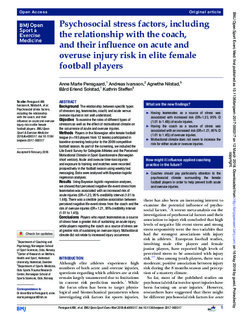| dc.contributor.author | Pensgaard, Anne Marte | |
| dc.contributor.author | Ivarsson, Andreas | |
| dc.contributor.author | Nilstad, Agnethe | |
| dc.contributor.author | Solstad, Bård Erlend | |
| dc.contributor.author | Steffen, Kathrin | |
| dc.date.accessioned | 2018-05-22T10:49:31Z | |
| dc.date.available | 2018-05-22T10:49:31Z | |
| dc.date.created | 2018-04-20T14:17:32Z | |
| dc.date.issued | 2018 | |
| dc.identifier.citation | BMJ Open Sport & Exercise Medicine. 2018, 4, e000317. | nb_NO |
| dc.identifier.issn | 2055-7647 | |
| dc.identifier.uri | http://hdl.handle.net/11250/2498682 | |
| dc.description | This is an Open Access article distributed in accordance with the Creative Commons Attribution Non Commercial (CC BY-NC 4.0) license, which permits others to distribute, remix, adapt, build upon this work non-commercially, and license their derivative works on different terms, provided the original work is properly cited and the use is non-commercial. See: http://creativecommons.org/licenses/by-nc/4.0/ | nb_NO |
| dc.description.abstract | Background: The relationship between specific types of stressors (eg, teammates, coach) and acute versus overuse injuries is not well understood. Objective: To examine the roles of different types of stressors as well as the effect of motivational climate on the occurrence of acute and overuse injuries. Methods: Players in the Norwegian elite female football league (n=193 players from 12 teams) participated in baseline screening tests prior to the 2009 competitive football season. As part of the screening, we included the Life Event Survey for Collegiate Athletes and the Perceived Motivational Climate in Sport Questionnaire (Norwegian short version). Acute and overuse time-loss injuries and exposure to training and matches were recorded prospectively in the football season using weekly text messaging. Data were analysed with Bayesian logistic regression analyses. Results: Using Bayesian logistic regression analyses, we showed that perceived negative life event stress from teammates was associated with an increased risk of acute injuries (OR=1.23, 95% credibility interval (1.01 to 1.48)). There was a credible positive association between perceived negative life event stress from the coach and the risk of overuse injuries (OR=1.21, 95% credibility interval (1.01 to 1.45)). Conclusions: Players who report teammates as a source of stress have a greater risk of sustaining an acute injury, while players reporting the coach as a source of stress are at greater risk of sustaining an overuse injury. Motivational climate did not relate to increased injury occurrence. | nb_NO |
| dc.language.iso | eng | nb_NO |
| dc.subject | coach | nb_NO |
| dc.subject | female | nb_NO |
| dc.subject | football | nb_NO |
| dc.subject | injury | nb_NO |
| dc.subject | stress | nb_NO |
| dc.title | Psychosocial stress factors, including the relationship with the coach, and their influence on acute and overuse injury risk in elite female football players | nb_NO |
| dc.title.alternative | Psychosocial stress factors, including the relationship with the coach, and their influence on acute and overuse injury risk in elite female football players | nb_NO |
| dc.type | Journal article | nb_NO |
| dc.type | Peer reviewed | nb_NO |
| dc.description.version | publishedVersion | nb_NO |
| dc.rights.holder | © Article author(s) (or their employer(s) unless otherwise stated in the text of the article) 2018. All rights reserved. No commercial use is permitted unless otherwise expressly granted. | nb_NO |
| dc.source.journal | BMJ Open Sport & Exercise Medicine | nb_NO |
| dc.identifier.doi | 10.1136/ bmjsem-2017-000317 | |
| dc.identifier.cristin | 1580674 | |
| dc.description.localcode | Seksjon for coaching og psykologi / Deparment of Coaching and Psychology | nb_NO |
| cristin.unitcode | 150,32,0,0 | |
| cristin.unitcode | 150,34,0,0 | |
| cristin.unitname | Seksjon for coaching og psykologi | |
| cristin.unitname | Seksjon for idrettsmedisinske fag | |
| cristin.ispublished | true | |
| cristin.fulltext | original | |
| cristin.qualitycode | 1 | |
